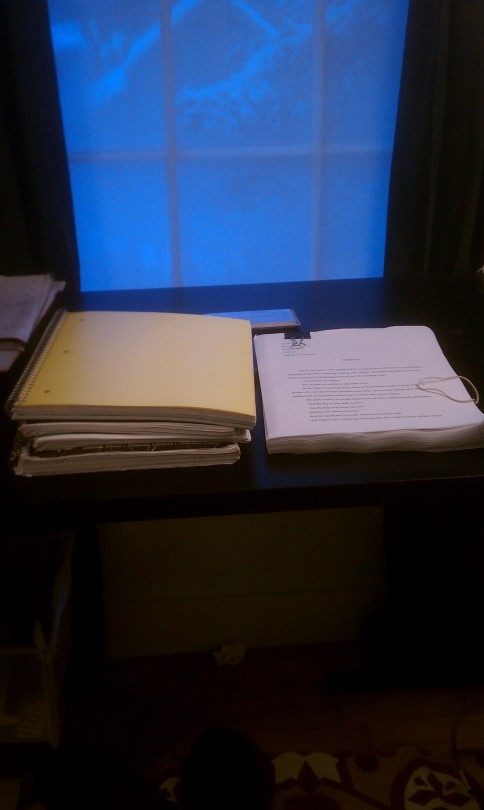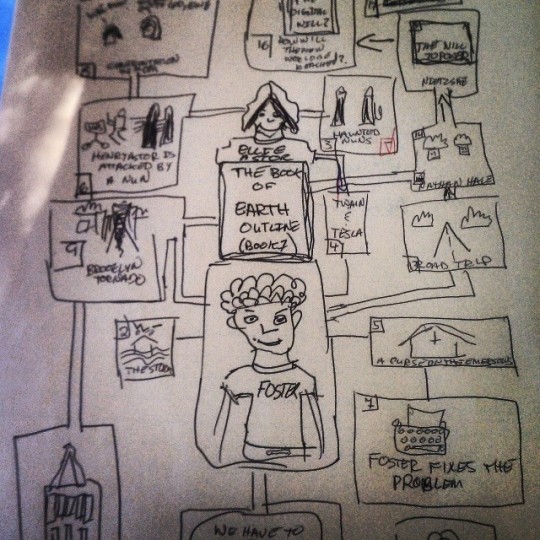This is continued from last week’s post.

[Image from the edit of the first draft of Human Library]
6. Structure each exercise as a separate exercise: within each exercise you’re working on a different element of telling a story. Each one will show you how your brain comes up with ideas. Think of it as stretching–you’re limbering up your brain to come up with ideas. Say you focus on a random object; like a slipper, a book, or a tree. Write a story in which your favorite color figures in prominently. The rest of the story doesn’t matter–just focus on one concrete thing.
7. Keep with one thematic element, but focus on point of view. First person, third person, whatever you like. Focus on the point of view from the previous story and try it in a different voice. See? We’re putting on weight and challenging ourselves.
8: Description. Go someplace interesting and use your senses. Describe the place. Use your eyes, ears, touch, smell, and taste senses. No thought verbs: thinks, knows, understands, realizes, believes, wants, remembers, imagines, desires, loves and hates. Try just using your physical senses.
9. When you’re done with that convey the emotion of the place. That’s how we show one’s thoughts, because emotion causes a physical reaction–our faces blush when someone we like gives us attention, fear occurs in the gut, “butterflies” when we’re nervous–stuff like that.
10. We’re done with the big stuff. Now it’s time for the fun stuff: choose a genre. Horror, sci-fi, romance, historical fiction. Time to build a world. Everything has a genre, even nonfiction. Memoir, historical, biographical, etc. This means you’re building a world-the laws, the hierarchy, the political parties, and religions. Those things are governed by character and everyone has different emotional realities. What does Character A want financially, professionally, creatively, and so on? What’s in their way of achieving those emotional wants and needs? One of the most interesting things about good writing is the environment your characters live in and how they come into conflict with that world. This is what makes the story real for the reader or the audience. That’s where connection happens because you’re using your physical senses to give the reader the feels. And every good story must, first and foremost, connect with the audience.
That leaves us with the last step, the most important in my mind–the characters. Give your characters limitations–we all have them. How about a character who can bench press cars but gets a hernia every time she does it? Or a blue person who lives in the sky?
Now for the final point of writing a book–each little story focuses on one thing and in order to have a complete vision one should use all these tools when writing a book. Perhaps the biggest challenge is the length of a novel or a book or a full film or a graphic novel. We’re talking tens of thousands of words, hundreds of pages, even more revisions. Usually novels run between 50 and 100,000 words or 250 to 500 pages. It’s a lot. But, you see, the thing is: there are 365 days in a year. If you write a page a day for a year, there you have a novel, or a book, or 365 poems. Sure, not all of those pages will be good, chances are good that at least a hundred of those pages will be needless. But you can do it. It just requires short, concerted focus, for one page a day, or ten minutes.
Is it more complex than that? Yes. But it doesn’t have to start that way. Just sit down, put pen or pencil to paper and go for it. I believe in you.

[Image from my first outline of the book]

Leave a comment